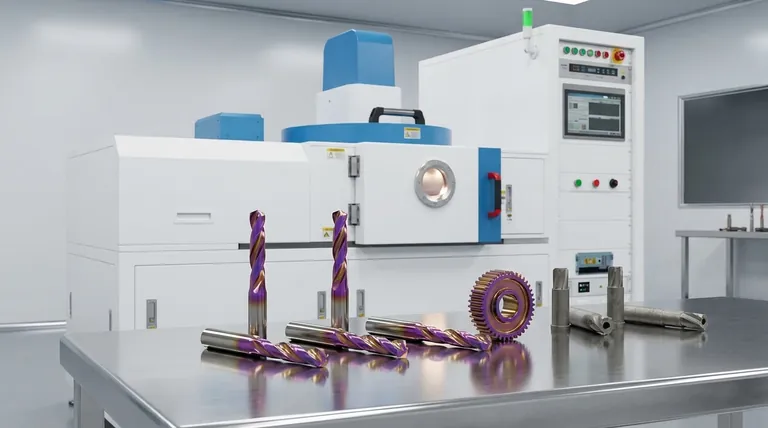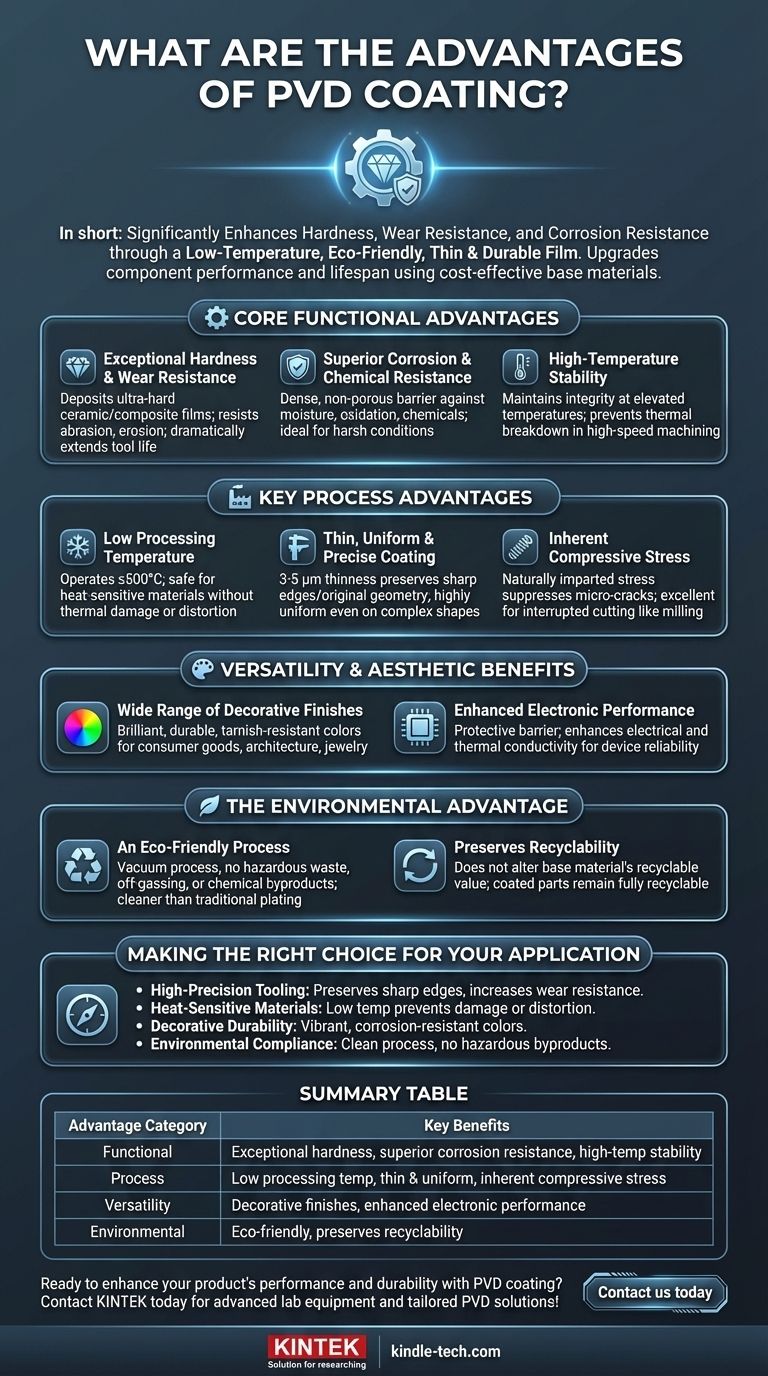In short, the primary advantages of Physical Vapor Deposition (PVD) coating are its ability to significantly enhance a material's hardness, wear resistance, and corrosion resistance. It accomplishes this through a low-temperature, environmentally friendly process that applies a very thin yet durable film, making it suitable for a vast range of applications from precision cutting tools to decorative finishes.
The core value of PVD is not just applying a protective layer, but fundamentally upgrading a component's performance and lifespan. It allows engineers and designers to use cost-effective base materials and imbue them with the surface properties of far more exotic and expensive materials, all while maintaining tight tolerances and environmental responsibility.

Core Functional Advantages
PVD coatings directly enhance the physical properties of a substrate's surface, leading to tangible improvements in performance and durability.
Exceptional Hardness and Wear Resistance
PVD can deposit ceramic and composite films with extremely high hardness. This creates a surface that is highly resistant to abrasion, erosion, and general wear.
This enhancement dramatically extends the functional life of components, particularly cutting tools, by reducing friction and preventing the base material from degrading under stress.
Superior Corrosion and Chemical Resistance
The PVD process creates a dense, non-porous layer that acts as a robust barrier between the substrate and its environment.
This barrier effectively protects against moisture, oxidation, and chemical attack, making PVD-coated parts ideal for use in harsh or corrosive conditions.
High-Temperature Stability
Many PVD coatings are engineered to maintain their hardness and integrity at elevated temperatures.
This property is critical for applications like high-speed machining, where significant heat is generated at the cutting edge. The coating prevents thermal breakdown and preserves tool performance.
Key Process Advantages
The method by which PVD is applied offers distinct benefits over other coating technologies, expanding its range of viable applications.
Low Processing Temperature
PVD is a relatively cool process, typically operating around 500°C or lower.
This is a significant advantage over high-temperature methods like Chemical Vapor Deposition (CVD), as it allows for coating heat-sensitive materials without the risk of thermal damage, distortion, or altering the substrate's fundamental temper.
Thin, Uniform, and Precise Coating
PVD coatings are remarkably thin, often between 3 and 5 micrometers (μm).
This thinness is crucial for applications requiring sharp edges, such as blades and cutting tools, as it preserves the original geometry without dulling the edge. The process also ensures a highly uniform coating, even on complex shapes.
Inherent Compressive Stress
During the cooling phase of deposition, the PVD process naturally imparts a compressive stress on the coating.
This internal stress is beneficial because it helps suppress the formation and propagation of micro-cracks. This makes PVD-coated tools exceptionally well-suited for interrupted cutting processes like milling, where the tool edge is subjected to repeated impact.
Versatility and Aesthetic Benefits
Beyond pure industrial performance, PVD offers a unique combination of broad applicability and high-quality finishes.
Wide Range of Decorative Finishes
PVD is not limited to industrial colors. It can produce a wide spectrum of brilliant, durable finishes in various colors.
These finishes are highly resistant to tarnishing, discoloration, and pitting, making PVD a superior choice for high-end consumer products, architectural components, and jewelry where both durability and aesthetic appeal are critical.
Enhanced Electronic Performance
In electronics, PVD coatings serve a dual purpose. They provide a protective barrier against wear and corrosion, extending component lifespan.
Simultaneously, specific PVD materials can be selected to enhance electrical and thermal conductivity, directly improving the performance and reliability of electronic devices.
The Environmental Advantage
Compared to traditional coating methods, PVD stands out as a far more sustainable and environmentally responsible technology.
An Eco-Friendly Process
The PVD process takes place in a vacuum and produces no hazardous waste, off-gassing, or chemical byproducts.
This makes it one of the cleanest coating technologies available, contrasting sharply with wet plating processes like chrome plating, which involve toxic chemical baths and disposal challenges.
Preserves Recyclability
Applying a PVD coating does not alter the inherent recyclable value of the base material. For example, PVD-coated stainless steel remains fully recyclable, preserving the value of the original metal.
Making the Right Choice for Your Application
Selecting PVD is a strategic decision based on your primary objective.
- If your primary focus is high-precision tooling: The thin, hard coating preserves sharp edges while dramatically increasing wear resistance for longer tool life.
- If your primary focus is protecting heat-sensitive materials: PVD's low processing temperature prevents substrate damage, distortion, or loss of temper.
- If your primary focus is decorative durability: The wide range of vibrant, corrosion-resistant colors offers a superior finish for consumer goods and architecture.
- If your primary focus is environmental compliance: PVD is an exceptionally clean process with no hazardous byproducts, simplifying regulatory concerns.
Ultimately, choosing PVD is a decision to enhance a product's material properties in a precise, reliable, and sustainable way.
Summary Table:
| Advantage Category | Key Benefits |
|---|---|
| Functional | Exceptional hardness, superior corrosion resistance, high-temperature stability |
| Process | Low processing temperature, thin & uniform coating, inherent compressive stress |
| Versatility | Wide range of decorative finishes, enhanced electronic performance |
| Environmental | Eco-friendly process, preserves recyclability of base materials |
Ready to enhance your product's performance and durability with PVD coating?
At KINTEK, we specialize in providing advanced lab equipment and consumables, including PVD coating solutions tailored to meet the demanding needs of laboratories and manufacturing facilities. Our expertise ensures your components gain superior hardness, wear resistance, and corrosion protection while maintaining environmental responsibility.
Contact us today to discuss how our PVD coating solutions can extend the lifespan of your tools, protect heat-sensitive materials, or add durable decorative finishes to your products!
Visual Guide

Related Products
- RF PECVD System Radio Frequency Plasma-Enhanced Chemical Vapor Deposition RF PECVD
- Chemical Vapor Deposition CVD Equipment System Chamber Slide PECVD Tube Furnace with Liquid Gasifier PECVD Machine
- Split Chamber CVD Tube Furnace with Vacuum Station Chemical Vapor Deposition System Equipment Machine
- VHP Sterilization Equipment Hydrogen Peroxide H2O2 Space Sterilizer
- Molybdenum Tungsten Tantalum Special Shape Evaporation Boat
People Also Ask
- What is plasma activated chemical vapour deposition method? A Low-Temperature Solution for Advanced Coatings
- How are PECVD and CVD different? A Guide to Choosing the Right Thin-Film Deposition Process
- What is an example of PECVD? RF-PECVD for High-Quality Thin Film Deposition
- Why is PECVD environment friendly? Understanding the Eco-Friendly Benefits of Plasma-Enhanced Coating
- How does RF power create plasma? Achieve Stable, High-Density Plasma for Your Applications



















